|
|
|
Sort Order |
|
|
|
Items / Page
|
|
|
|
|
|
|
| Srl | Item |
| 1 |
ID:
193310
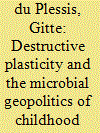

|
|
|
|
|
| Summary/Abstract |
Engaging Catherine Malabou's philosophical work on biological plasticity, this article combines microbiological and geopolitical analysis of the deadliest manifestations of childhood malnutrition. At the scale of microbiology, childhood malnutrition is a devastating condition and a mystery to which it seems microbiomes – the ecosystems of microbes in the gut – hold a key. At the scale of geopolitics, childhood malnutrition is a calamity generated by racial capitalism, poverty, and underdevelopment. What should we do with the plasticity that makes us? Malabou asks. Engaging philosophically with the plastic materiality of microbiomes in childhood malnutrition, the article focuses on destructive plasticity as an ontological alternative to what science on malnutrition pursues as a problem of causality. This leads to an argument that medicine, as well as humanitarian, security, and development interventions, must reckon with the destructive plasticity of what is in essence a political disease of annihilation. The article ends by speculating on resistance via the biological act of nurturing.
|
|
|
|
|
|
|
|
|
|
|
|
|
|
|
|
| 2 |
ID:
193306
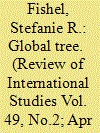

|
|
|
|
|
| Summary/Abstract |
Forest ecosystems are crucial to survival on Earth. This article argues that trees and forests are both vital components of a healthy Earth system and productive examples for expanding International Relations’ disciplinary boundaries. The article discusses the forest in three contexts: the global, the (post)colonial, and from the tree itself. From tree planting as a practice of social and environmental justice, to postcolonial and Indigenous science and knowledge, to the mycorrhizal ‘wood wide web’, a focus on trees, forests, and biosphere opens the possibility for a multispecies IR. Through a consideration of trees and forests in law, treaty, culture, and science at the local and global level, this article adds to a growing literature in IR that strives to bring the non-human, more-than-human, or other-than-human creatively and productively into the discipline. Foregrounding the forest's materiality and trees’ symbolic power for human cultures opens important pathways to understanding how the non-human is, and should, alter and affect global politics.
|
|
|
|
|
|
|
|
|
|
|
|
|
|
|
|
| 3 |
ID:
193305
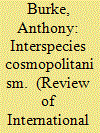

|
|
|
|
|
| Summary/Abstract |
Cosmopolitanism claims to be the most just and inclusive of mainstream approaches to the ethics and practice of world order, given its commitment to human interconnection, peace, equality, diversity, and rights, and its concern with the many globalised pathologies that entrench injustice and vulnerability across borders. Yet it has largely remained oblivious to the agency, power, and value of non-human life on a turbulent and active Earth. Without rejecting its commitments to justice for human beings, the article challenges its humanism as both morally and politically inadequate to the situation of the Anthropocene, exemplified by the simultaneous crises of climate change, mass extinction, and the COVID-19 pandemic. In answer, the article develops new grounds and principles for an interspecies cosmopolitanism, exploring how we can reimagine its ontological foundations by creating new grounding images of subjectivity, existential unity, institutional organisation, and ordering purpose. These, in turn, can support political and institutional projects to secure the rights of ecosystems and people to flourish and persist through an increasingly chaotic epoch of human dominance and multispecies vulnerability across the Anthropocene Earth.
|
|
|
|
|
|
|
|
|
|
|
|
|
|
|
|
| 4 |
ID:
193307


|
|
|
|
|
| Summary/Abstract |
Rats tend to thrive wherever humans do. In recent centuries, the growth of human populations around the planet has meant the growth of a nearly equivalent global population of rats, particularly in cities, where they thrive on trash, food scraps, and infrastructure, and widely stymie human efforts to get rid of them. This forced coexistence has inspired a wide range of human responses, ranging from revulsion and extermination efforts as vermin, to religious veneration and use as experimental lab animals. At the same time, the political figure of the rat has played a constitutive role in violence and experimentation against human populations who are deemed as rat-like. To understand these linked dynamics, the article frames the idea of interspecies internationality, against both Anthropocene and geopolitical readings of the planetary condition. It then elaborates three axes around which rat assemblages have been formed – exterminative, experimental, and ecological. The article concludes by arguing that the rat, as interspecies figure of politics and as living creature, allows us to understand important dynamics around the generation of disposable life, political difference, and conditions of coexistence, in ways that are critical to the entwined politics of life on the planet.
|
|
|
|
|
|
|
|
|
|
|
|
|
|
|
|
| 5 |
ID:
193304
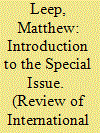

|
|
|
|
|
| Summary/Abstract |
The contributions to this Special Issue examine multispecies perspectives on the political dynamics of international life. Building on this theme, I consider the complex and manifold ways in which the subject of security can be understood in terms of more-than-human personhood. First, by thinking of more-than-human animals as phenomenally conscious persons, we might better appreciate the multispecies complexity of security as an agentic and affective experience. Second, attending to the spiritual character of certain indigenous articulations of personhood presses us to decipher how spiritual claims might inform moral and legal dimensions of multispecies security-seeking behaviour. To illustrate the significance of these moves, I first draw on more-than-human experiences of war, pathogenic viruses, and the global factory farm. I then explore conceptions of spiritual personhood in the context of Ojibwe responsibilities to protect wolves. These perspectives on personhood demonstrate possibilities for cultivating greater interest in the multispecies experience of security.
|
|
|
|
|
|
|
|
|
|
|
|
|
|
|
|
| 6 |
ID:
193308
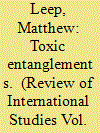

|
|
|
|
|
| Summary/Abstract |
This article explores avian experiences with toxic war processes that unfold across space and time. Joining together three evolving areas of interest in global politics – ontologies of war, interspecies relations, and sensory politics – the article develops a view of war that centres ongoing war processes that affect more-than-human life in and outside of international warzones. Advancing a multispecies form of inquiry attentive to local voices, including Upper Cook Inlet Tribes, the article examines how interspecies relations emerge in national security debates about long-lasting ecological costs of war. Specifically, it offers an analysis of US Department of Defense hearings surrounding the controversy over reopening Eagle River Flats – an Alaskan estuary that had been polluted with white phosphorus munitions – for weapons testing and training during the Iraq War. The article also considers the experiences of two migratory avian communities (northern pintails and tundra swans) with toxic white phosphorus pollution, illustrating more-than-human sensory perspectives on the space and time of war processes. These conceptual and empirical moves reposition national security concerns about wartime risk into a much broader post-anthropocentric perspective.
|
|
|
|
|
|
|
|
|
|
|
|
|
|
|
|
| 7 |
ID:
193309
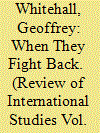

|
|
|
|
|
| Summary/Abstract |
Since humanity is no longer the epistemological, ontological, or moral measure of all things, then (how) should international political theorists rethink animal politics? The archive ‘When They Fight Back’ records incidences of when animals ‘fought back’. It explores ways of conceptualising resistance and the implications of broadening the concept to include non-human actors via three findings: (1) Animal conflicts are everywhere and classifying them as revolt, reaction, and resistance is a creative exercise that encourages reflections about interspecies relations; (2) Most animal/human conflicts are not treated as ‘conflicts’. Instead, they are normalised within a biopolitical discourse that seeks to reduce resistance (characterised as Animal living) in order to promote living (characterised as Human resistance). (3) If excluded, animal resistance finds its way back into literatures via ethical-aesthetic figurations, traces, and desires ‘for’ the Animal. As such, the archive stages a Clausewitzian case of escalation from resistances into total war. In open hostility towards a perceived enemy, animals fight back – and because they fight back, humanism has built its own form of resistance (i.e., politics, ethics, aesthetics, biopolitics, international relations, etc.). I conclude that Human Being (as a form of resistance) must be surrendered if the war on life itself is to end.
|
|
|
|
|
|
|
|
|
|
|
|
|
|
|
|
| 8 |
ID:
193311
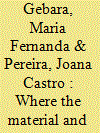

|
|
|
|
|
| Summary/Abstract |
Forests, and ways of relating to forests, are critical to the planet, yet largely neglected in IR. In this article, we engage with the debate on the Anthropocene and explore different forms of relationality to forests and Amazonian indigenous symbolism. Drawing mainly on political sociology, political ecology, and anthropology, we approach the Amazon basin as a site where nature, culture, resource extraction, and spirituality are enmeshed, and discuss material and symbolic meanings of the forest. The article starts by briefly reviewing discourses around the Anthropocene. It then looks at Amazonian countries with a specific focus on the classist foundations of socioecological exploitation that underpin anthropocentric attitudes and practices, and analyses the material way of perceiving the Amazon. It proceeds by addressing the diverse symbolism present in indigenous traditional knowledge; symbolism that may help in moving politics and society beyond the dominant attitudes that initiated the Anthropocene. Finally, the article offers possibilities for perceiving the forest differently and intertwining the Amazon's material and symbolic worlds.
|
|
|
|
|
|
|
|
|
|
|
|
|
|
|
|
|
|
|
|
|